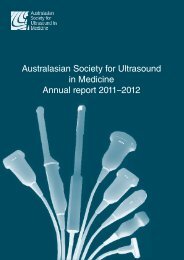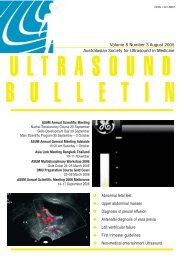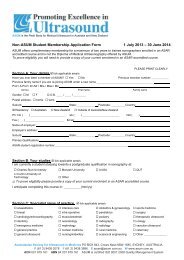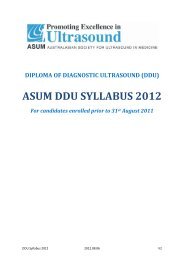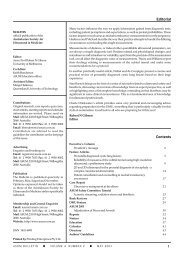Volume 6 Issue 3 - Australasian Society for Ultrasound in Medicine
Volume 6 Issue 3 - Australasian Society for Ultrasound in Medicine
Volume 6 Issue 3 - Australasian Society for Ultrasound in Medicine
- No tags were found...
Create successful ePaper yourself
Turn your PDF publications into a flip-book with our unique Google optimized e-Paper software.
<strong>Ultrasound</strong> of salivary glands<br />
Approximately 90% arise from the superficial lobe and are<br />
adequately assessed by ultrasound alone. In about 25% of<br />
pleomorphic adenomas there are associated small satellite<br />
nodules away from the ma<strong>in</strong> tumour 16 . Malignant<br />
trans<strong>for</strong>mation and calcification are known to occur <strong>in</strong> long<br />
stand<strong>in</strong>g tumour 17 . Recurrence rate varies between 1% and<br />
50% 18 .<br />
On ultrasound this tumour appears as a homogeneous,<br />
hypoechoic solid mass, usually less than 3cm <strong>in</strong> size (Figure<br />
5). It is round or oval <strong>in</strong> shape and well-def<strong>in</strong>ed with<br />
lobulated marg<strong>in</strong>s. Quite often there is posterior acoustic<br />
enhancement. Lesions larger than 3cm are more prone to<br />
cystic or haemorrhagic degeneration which modify the<br />
<strong>in</strong>ternal architecture and may also exhibit ill-def<strong>in</strong>ed edges,<br />
thus mak<strong>in</strong>g differentiation from a malignant lesion difficult.<br />
Calcification may also occur <strong>in</strong> longstand<strong>in</strong>g tumour.<br />
Figure 4 Transverse gray scale sonogram of the right<br />
submandibular gland show<strong>in</strong>g glandular enlargement with<br />
lobulated outl<strong>in</strong>e and ‘cirrhotic-like’ echopattern. These<br />
features represent chronic scleros<strong>in</strong>g sialadenitis (Kuttner<br />
tumour).<br />
Salivary gland neoplasms<br />
Patients with salivary gland tumour usually present with a<br />
palpable lump. In evaluat<strong>in</strong>g a focal mass <strong>in</strong> a salivary gland,<br />
the first step is to identify if the mass is <strong>in</strong>traglandular or<br />
extraglandular. Up to 20% of cl<strong>in</strong>ically diagnosed salivary<br />
gland masses are found by ultrasound to be due to lesions<br />
outside the salivary gland 13 . For a parotid lesion, it is<br />
important to determ<strong>in</strong>e its deep lobe <strong>in</strong>volvement, as the<br />
surgical approach would be different. In cases of extensive<br />
deep parotid lobe <strong>in</strong>volvement, extra-parotid components<br />
such as parapharyngeal space extension, ultrasound alone<br />
is <strong>in</strong>sufficient to assess the full tumour extent. Cross-sectional<br />
imag<strong>in</strong>g with computed tomography (CT) or magnetic<br />
resonance imag<strong>in</strong>g (MRI) is necessary <strong>in</strong> these circumstances.<br />
Once it is established that the neoplasm is <strong>in</strong>tra-glandular<br />
<strong>in</strong> orig<strong>in</strong>, the next step is to determ<strong>in</strong>e its nature, i.e. benign<br />
or malignant. The ultrasound dist<strong>in</strong>ction of benign and<br />
malignant lesions is not precise, but certa<strong>in</strong> features should<br />
raise suspicion <strong>for</strong> malignancy. These <strong>in</strong>clude: if the marg<strong>in</strong><br />
of the lesion is ill-def<strong>in</strong>ed or is locally <strong>in</strong>vasive, if the mass is<br />
<strong>in</strong> the deep lobe, and if abnormal cervical lymph nodes are<br />
present. <strong>Ultrasound</strong> is able to diagnose a benign lesion <strong>in</strong><br />
over 80% of cases 14 . Colour Doppler may help <strong>in</strong> diagnos<strong>in</strong>g<br />
malignancy when there is disorganized <strong>in</strong>ternal colour flow.<br />
The accuracy can be further enhanced by FNAC under<br />
ultrasound guidance, particularly with the help of an<br />
experienced cytopathologist 15 .<br />
Benign neoplasms<br />
1. Pleomorphic adenoma<br />
Pleomorphic adenoma is the most common (60-80%) of the<br />
parotid neoplasms. Women are more commonly affected<br />
than men and patients are usually greater than 40 years of<br />
age at the time of diagnosis. It is ten times more common <strong>in</strong><br />
the parotid gland than <strong>in</strong> submandibular gland.<br />
Figure 5 Transverse gray scale sonogram show<strong>in</strong>g a welldef<strong>in</strong>ed,<br />
round, homogeneous, hypoechoic lesion <strong>in</strong> the left<br />
submandibular gland. These features suggest a benign salivary<br />
gland lesion. Note the posterior acoustic enhancement<br />
commonly seen with pleomorphic adenoma.<br />
The colour Doppler pattern of pleomorphic adenoma is<br />
variable but commonly shows <strong>in</strong>creased peripheral vessels,<br />
ma<strong>in</strong>ly venous <strong>in</strong> nature 19 .<br />
2. Warth<strong>in</strong>’s tumour (adenolymphoma)<br />
Warth<strong>in</strong>’s tumour account <strong>for</strong> 6-10% of all salivary gland<br />
neoplasms. It is more common <strong>in</strong> elderly men than women.<br />
The apex of the superficial lobe of parotid gland is the<br />
commonest site of <strong>in</strong>volvement. About 15-30% are bilateral.<br />
On ultrasound, a Warth<strong>in</strong>’s tumour is typically a welldef<strong>in</strong>ed<br />
hypoechoic lesion with <strong>in</strong>ternal heterogeneity of<br />
solid and cystic areas (Figure 6). It may also appear anechoic<br />
with through transmission. Colour flow Doppler may show<br />
vessels <strong>in</strong> a hilar distribution.<br />
3. Others<br />
Other benign neoplasms such as lipoma (Figure 7),<br />
oncocytoma and haemangioma are less commonly seen.<br />
Malignant neoplasms<br />
Malignant epithelial tumours of salivary gland account <strong>for</strong><br />
17% of all epithelial tumours. The smaller salivary glands<br />
have greater malignant potential, a tumour <strong>in</strong> the subl<strong>in</strong>gual<br />
or submandibular gland be<strong>in</strong>g more likely to be malignant<br />
than a tumour <strong>in</strong> the parotid gland. <strong>Ultrasound</strong> alone may<br />
20 ASUM ULTRASOUND BULLETIN VOLUME 6 NUMBER 3 AUGUST 2003





